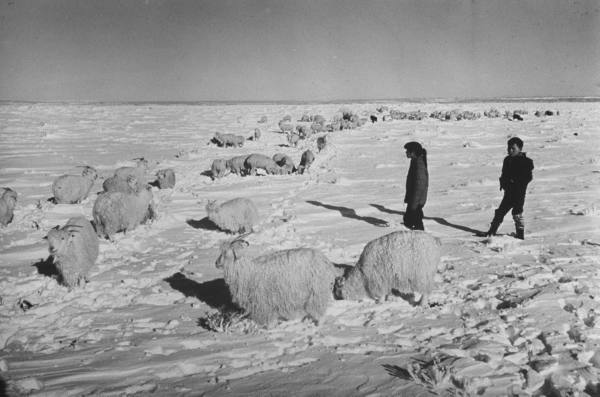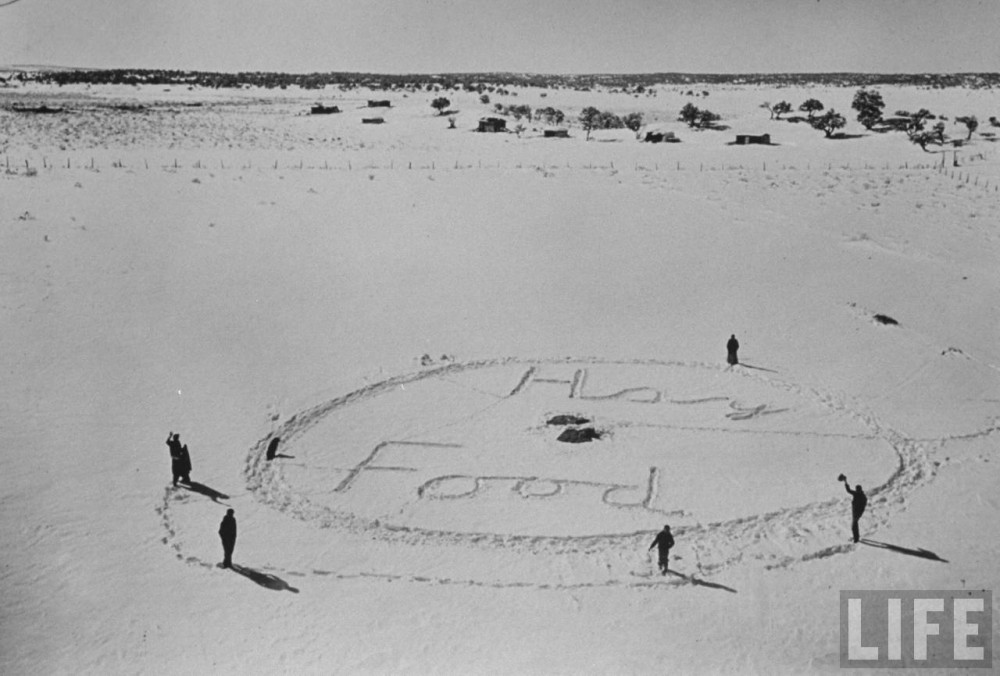
50 years ago: Worst storm of 20th Century hits rez

Flock belonging to Navajo shepherds foraging in deep snow of severe winter. (Ralph Crane/Life magazine, 1967.)

Navajo shepherds hard hit by snow storm stamped out a sign requesting food & hay in 1967. (Ralph Crane, Life magazine.)
It was the last week in December of 1967 and residents of the Navajo Reservation were thoroughly disgusted with the weather.
Over the past 17 days, the reservation had been hit by four different snowstorms and life on the reservation had been totally disrupted.
Snowstorms were nothing new, but in the past, reservation residents had had a chance to recuperate before the next patch of bad weather hit. A snowstorm would hit but by the next afternoon, the main roads would be drivable and secondary roads, which would be clogged with mud in the afternoon, would be drivable in the early morning hours when the roads were frozen.
In 1967, having one storm after another made it difficult for any travel and some Navajo families had been stranded for more than two weeks with no end in sight.
The Navajo Times would say it was the worst snow emergency of the century with the loss of livestock projected by tribal officials to be more than 25,000, with many Navajo families losing their whole herds.
Helicopters from Kirtland Air Force Base were dropping some hay in the areas around Chinle and Tuba City but, for the most part, they were still concentrating most of their efforts on bringing food to houses where familily members had hung out blankets or messages pleading for food.
Navajo Tribal Chairman Raymond Nakai had been on the radio, speaking in Navajo, asking families who were stranded with someone in their house sick or in need of medicine to post a message on their roof or near their house so that helicopters on the way back to Window Rock after dropping off food could airlift those with medical emergencies back to Gallup for treatment.
On Dec. 26, the Farmington Times published a front page story detailing some of the problems the Navajo Police had in trying to help Navajo families during the snow crisis.

Flock belonging to Navajo shepherds foraging in deep snow of severe winter. (Ralph Crane/Life magazine, 1967.)
Shiprock police had had a “demanding” task since the snowstorms began, the paper said, especially in providing help to Navajos living in Tohatchi, Newcomb, Cove, Teec Nos Pos, Fruitland and Aneth, with the first three chapters having received the most snowfall during the past two weeks.
Some families living in these communities had to stay over in Shiprock for a day or more until roads became passable to their areas. The police barracks in Shiprock had been set aside as temporary sleeping quarters and, on at least one night, the barracks were so crowded that cots had to also be put in the lobby as well.
And when travel by car became impossible, officers such as Stanley Hammond and Thomas Manuelito volunteered to walk to homes in the Four Corners area to check on the welfare of the families.
“But patrolman James Paddock,” said the Daily Times, “seemed to have more than his share of the work. Stationed in Cove, he had a long hunt for a mental patient who wandered off from his home during the area’s first storm.
“It was at night and the search led into some pretty rough country. He did have some assistance when five other persons joined in to help.”
Once the person was found and taken to safety, Paddock only had a few minutes to rest before he was called on to take two expectant mothers to the Shiprock hospital, the paper added.
Just how hard was this?
The Farmington Daily Times said it took Paddock more than five hours to travel the 44 miles to the hospital, requiring him at times to use his car to plow through snowdrifts as high as four feet. He later reported his unit got stuck in the snow three times during the trip.
At one point, he said, he had to get out of the unit because he couldn’t even find the road anymore. At another point, his unit was behind a car that stalled on the road and required help from a helicopter to have his unit pulled around the stalled car.
Other papers across the nation had been telling Americans the problems the Navajos had been having because of the storms.
A reporter for the New York Times spent three days in the area along with a photographer and the paper set aside a full page for a photo essay and story about how the tribal members were coping or not coping with the storm.
Nakai had been issuing almost daily press releases reporting on what tribal departments were doing to provide help to Navajo families and reporting on help coming in from all over the country.
One church in Missouri sent a couple of hundred Bibles as well as blankets and toys for both boys and girls. The toys came in already packaged with no information on what was inside or what age level the toys were meant for so volunteers had to unwrap all of the gifts, figure out the age level and gender for the gift and then rewrap it.
The good news was that as the year ended, weather reports indicated that skies should remain clear for several days, allowing stranded families a chance to finally get out of their homes to buy supplies in case another storm hit after the first of the year.
Nakai asked chapter officials to write up a report by the end of the year, asking what the chapter had done to help its members and to give the tribe an idea of just how serious their problems were.
Tribal officials planned to use these reports as part of a plea to the federal government to provide funding to help Navajo families get back on their feet.
The big question, however, was whether tribal members would receive any financial help from either the tribe or the federal government to help replace livestock that died during the storm.
The Bureau of Indian Affairs was still saying that there were too many livestock on the reservation so it was questionable whether any money would be made available to replace them.
To read the full article, pick up your copy of the Navajo Times at your nearest newsstand Thursday mornings!
Are you a digital subscriber? Read the most recent three weeks of stories by logging in to your online account.







 Highway 264,
Highway 264, I-40, WB @ Winslow
I-40, WB @ Winslow